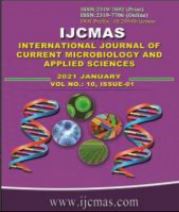


 National Academy of Agricultural Sciences (NAAS)
National Academy of Agricultural Sciences (NAAS)

|
PRINT ISSN : 2319-7692
Online ISSN : 2319-7706 Issues : 12 per year Publisher : Excellent Publishers Email : editorijcmas@gmail.com / submit@ijcmas.com Editor-in-chief: Dr.M.Prakash Index Copernicus ICV 2018: 95.39 NAAS RATING 2020: 5.38 |
The 150 chicks of day old Giriraja breed were procured from Govt. Regional Hatchery, Nagpur (Maharashtra). Which were divided into five treatment groups T1, T2, T3, T4, and T5 with 30 numbers of chicks in each group. The dietary treatments consisted of one basal control (T1), supplemented with 1.0 % Black cumin seed powder (T2), 1.5 % Black cumin seed powder (T3), 1.75 % Black cumin seed Powder (T4), and 2.0 % Black cumin seed powder (T5). Body weight and feed consumption were recorded at weekly interval. Feed conversion ratio, dressing percentage, economics of broiler production were calculated. Black cumin seed powder feeding were done separately and compared by completely randomized design (CRD).The body weight of the significantly better growth was recorded in T3 (1329.73) and followed by T4 (1172.50). The higher feed consumption was recorded in T1 followed by T2. The data indicates that higher feed conversion efficiency in T1 whereas less feed conversion efficiency observed in treatment T3 (1.5% BC) followed by the T2 (1% BC). Numerically higher dressing percentage was recorded in treatment T3 (72.14) and followed by T2 (70.81). It seems that the highest profit was received for the treatment T3 (1.5% BC) follow by T2 (1% BC) and standard feed control.
 |
 |
 |
 |
 |